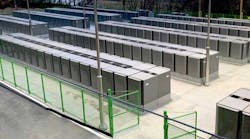Bloom Energy Bringing Fuel Cell Power to CoreWeave Data Center Project in Illinois
Bloom Energy will supply solid oxide fuel cell energy technology for hyperscale developer CoreWeave’s data center project in Illinois --and perhaps beyond-- as the data industry grows exponentially and seeks out cleaner, resilient, and on-site power.
As artificial intelligence (AI) and cloud-based capacity continue to expand by leaps and bounds, those new facilities will require electrical generation capacity, which can be met by lower carbon resources and microgrids. A research report by Goldman Sachs recently forecasted that at least 47 GW of new data center construction will happen by 2030.
All those new gigawatts will require primary and backup power. The CoreWeave strategic partnership with Bloom Energy will utilize the latter’s proprietary fuel cells to generate electricity for a high-performance data center owned by Chirisa Technology Parks in Volo, Illinois.
CoreWeave provides graphic processing unit cloud-based chip capacity to data centers. The boom in AI has suddenly elevated the company into the stratosphere of cloud computing development, as evidenced by a $1.1 billion new funding round announced in May, featuring investors such as Fidelity and Altimeter Capital.
“Bloom Energy is thrilled to have been selected by CoreWeave,” Aman Joshi, Bloom Energy’s chief commercial officer, said in a statement. “This validation from CoreWeave, a leader in AI, is a testament to our leading-edge technology and its importance to AI.”
The Volo data center, owned by Chirisa Technology Parks, is a 160,000-square-foot facility with a 14-MW power supply and advanced cooling systems. The Bloom Energy fuel cells are scheduled to be commissioned by the third quarter of 2025, according to reports.
The mission criticality of data centers, which is on an unrelenting growth spurt in the era of new generative AI and cloud-based storage, does not lend itself to intermittent renewables or less energy-dense resources such as solar and storage microgrids. Instead, they require baseload-level power.
“We are seeing a lot of microgrid providers of natural gas solutions or fuel cells offering a 24/7 solution for these larger loads to address utility constraints,” Elham Akhavan, senior microgrid research analyst at Wood Mackenzie, told Microgrid Knowledge back in April. “Up until recently , large load facilities have had a backup solution and have been grid connected. But because of grid constraints, they are choosing to be off-grid.”
Fuel-cell technology uses an electrochemical process to convert a fuel, such as natural gas or hydrogen, into electricity with only water vapor and heat as the emissions.
Bloom Energy last month announced a collaboration with Sembcorp Industries to potentially utilize the solid oxide fuel cell technology and carbon capture to provide low-carbon power for data centers in Singapore.
In May, semiconductor giant Intel Corp. and Bloom Energy announced a power capacity agreement focused on delivering fuel cell technology for Intel’s data center in Santa Clara, Calif. Bloom Energy also is a long-term energy supplier for Intel.
The International Energy Agency predicts that global data center electricity demand will more than double in coming years, as the growth of AI plays a huge role in that expansion. Data centers and data transmission currently consume between 2% and 3% of total electricity load worldwide, according to multiple reports, but that could increase and is causing utilities and developers to accelerate power generation options.








